mobile View, to the German Version tap the flag


- Khanate of Bukhara
- also: Emirate of Bukhara
- former Turkestani state
- own name: Bokhara
• Flags
• Meaning/Origin of the Flag
• Map
• Numbers and Facts
• History
• Origin of the Country's Name
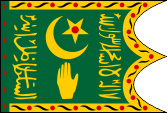
19th–20th cent.,
Flag of the Khan of Bukhara,
Source, by: Flags of the World



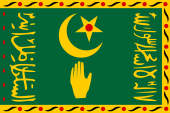
Flag of the Khan of Bukhara,
ratio = 2:3,
shape opitmized by: Volker Preuss



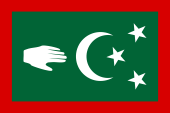
19th–20th cent.,
Flag of the Khanate of Bukhara,
Source, by:
Flags of the World



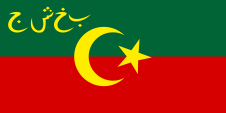
1920–1921,
Flag of the Socialistic People’s Republic of Buchara
ratio = 1:2,
Source, by: Flags of the World



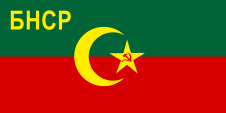
1921–1923,
Flag of the Socialistic People’s Republic of Buchara
ratio = 1:2,
Source, by: Flags of the World



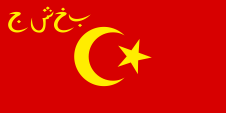
1923–1923,
Flag of the Socialistic People’s Republic of Buchara
ratio = 1:2,
Source, by: Flags of the World



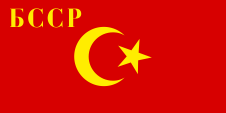
1924–1925,
Flag of the Socialistic Republic of Buchara (?),
ratio = 1:2,
Source: no source to be determined anymore




The flag of the Khan of Bukhara showed a with a showy border surrounded green bunting with a golden half-moon and a star, the symbols of Islam but even of the Turks, completed by the hand of Fatima (symbol of luck), the daughter of Prophet Mohammed, as well as arabian inscriptions. After the end of the monarchy after a communist coup d’état, the arabian signs had been removed as well as the hand of Fatima, and the initials of the country were added in the upper staff quadrant, and the half of the flag has to be ceded for the communist red. Since 1923 it was only single-coloured red.
Source: Volker Preuss,
Flags of the World

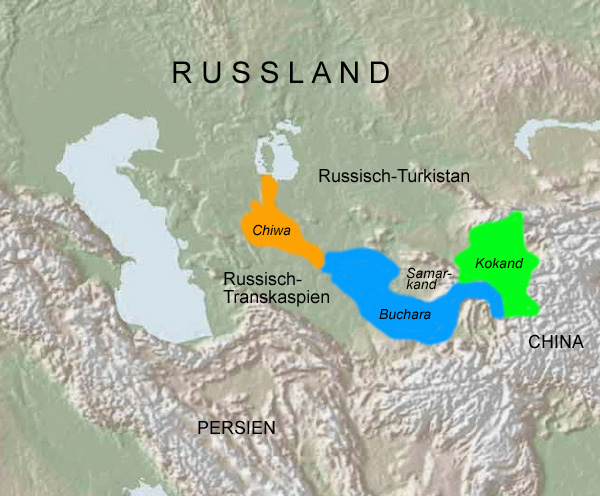
Landkarte: Freeware, University of Texas Libraries, modyfied by: Volker Preuss

Area: 92.278 square miles
Inhabitants: 2.130.000 (1885)
Density of Population: 2 inh./sq.mi.
Capital: Buchara, 70.000 inh. (1885)
official Languages: Uzbek, Toijik
other Languages: Turkmen, Kirghiz, Arabian
Source: RetroBib Retrobibliothek

antiquity · settlement by Iranian nations
5th century A.D. · immigration of Turk nations
8th century · Arabian conquest, islamization
714–874 · part of the Arabian Califate
10th–11th century · Maverannah State (Transoxania) under the Samanids
11th century · conquest by the Selchuks
1218–1226 · conquest by the Mongols under Dshingis Khan and his successors
1363 · end of the Mongol rule, invasion of Timur
8th of April 1369 · Timur becomes Emir of Transoxania with royal seat in Samarkand
15th century · migration of Uzbeks (named after Ösbek Khan, a ruler of the Golden Horde) under the leadership of Abulkhair Khan
1500 · conquest by the Uzbeks under Sheibani Mehemmed Chan, a descendant of Dshingis Khan, establishment of the Khanate of Buchara
1597 · with the death of Abdullah Chan ends the reign of the Dshingids
1597–1737 · dynasty of the Ashtarkhanids as Uzbek Chans
ca. 1710 · the Uzbek Shah-Rukh establishes the Khanate of Kokand by separation of Fergana Valley from the Khanate of Bukhara
1747–1756 · the country is occupied by Persian troops
since 1785 · dynasty of the Mangits as Uzbek Chans (title Emir)
1826–1860 · rule of Nasrullah Bahadir Chan, numerous wars against Kokand Khiva, Persia and Afghanistan
1842 · conquest of Kokand
1864–1868 · gradually Russian conquest
30th of June 1868 · the Khanate of Bukhara becomes a vassal of Russia, cede of Samarkand to Russia
1917 · bolshevist coup d’état in Russia
1917–1918 · civil war
March 1918 · Soviet Russia recognizes the Khanate of Bukhara
August 1920 · coup d’état of the Communist Party of Bukhara, invasion of Soviet Russia
2nd of September 1920 · conquest of Bukhara Town by troops of Soviet Russia, the Emir escapes to Afghanistan, proclamation of the Soviet Republic of Bukhara
18th of October 1920 · proclamation of the Socialistic People’s Republic of Bukhara
1920–1923 · civil war
4th of March 1921 · alliance with Soviet Russia, Soviet Russia recognizes de facto the independence of Bukhara, but apprehension of the whole leadership of the country by the communists
19th of September 1924 · proclamation of the Socialistic Republic of Bukhara
17th of February 1925 · dissolution of the Socialistic Republic of Bukhara, annexion to Soviet Uzbekistan
Source:
RetroBib Retrobibliothek,
World Statesmen,
Wikipedia (D)

The name "Bukhara" has its roots in a buddhist dynasty of the early middle ages, which gave the town its name. It has ancient indian roots and descends from the word "Bihara" what means "Monastery".
Source: Handbuch der geographischen Namen


![]()









